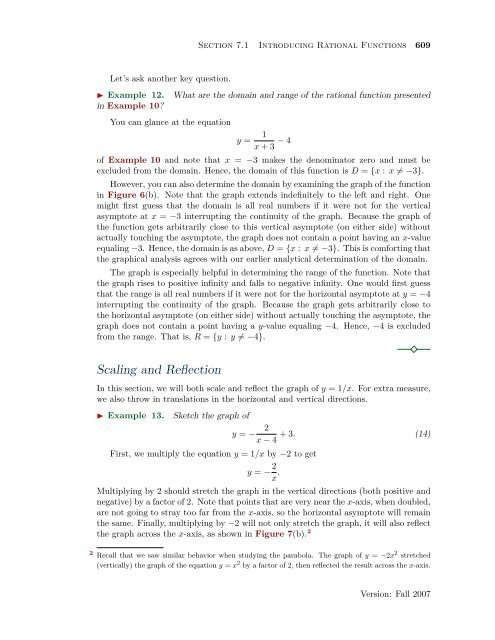Chapter 7 Rational Functions - College of the Redwoods
Chapter 7 Rational Functions - College of the Redwoods
Chapter 7 Rational Functions - College of the Redwoods
Create successful ePaper yourself
Turn your PDF publications into a flip-book with our unique Google optimized e-Paper software.
Section 7.1 Introducing <strong>Rational</strong> <strong>Functions</strong> 609<br />
Let’s ask ano<strong>the</strong>r key question.<br />
◮ Example 12.<br />
in Example 10?<br />
You can glance at <strong>the</strong> equation<br />
What are <strong>the</strong> domain and range <strong>of</strong> <strong>the</strong> rational function presented<br />
y = 1<br />
x + 3 − 4<br />
<strong>of</strong> Example 10 and note that x = −3 makes <strong>the</strong> denominator zero and must be<br />
excluded from <strong>the</strong> domain. Hence, <strong>the</strong> domain <strong>of</strong> this function is D = {x : x ≠ −3}.<br />
However, you can also determine <strong>the</strong> domain by examining <strong>the</strong> graph <strong>of</strong> <strong>the</strong> function<br />
in Figure 6(b). Note that <strong>the</strong> graph extends indefinitely to <strong>the</strong> left and right. One<br />
might first guess that <strong>the</strong> domain is all real numbers if it were not for <strong>the</strong> vertical<br />
asymptote at x = −3 interrupting <strong>the</strong> continuity <strong>of</strong> <strong>the</strong> graph. Because <strong>the</strong> graph <strong>of</strong><br />
<strong>the</strong> function gets arbitrarily close to this vertical asymptote (on ei<strong>the</strong>r side) without<br />
actually touching <strong>the</strong> asymptote, <strong>the</strong> graph does not contain a point having an x-value<br />
equaling −3. Hence, <strong>the</strong> domain is as above, D = {x : x ≠ −3}. This is comforting that<br />
<strong>the</strong> graphical analysis agrees with our earlier analytical determination <strong>of</strong> <strong>the</strong> domain.<br />
The graph is especially helpful in determining <strong>the</strong> range <strong>of</strong> <strong>the</strong> function. Note that<br />
<strong>the</strong> graph rises to positive infinity and falls to negative infinity. One would first guess<br />
that <strong>the</strong> range is all real numbers if it were not for <strong>the</strong> horizontal asymptote at y = −4<br />
interrupting <strong>the</strong> continuity <strong>of</strong> <strong>the</strong> graph. Because <strong>the</strong> graph gets arbitrarily close to<br />
<strong>the</strong> horizontal asymptote (on ei<strong>the</strong>r side) without actually touching <strong>the</strong> asymptote, <strong>the</strong><br />
graph does not contain a point having a y-value equaling −4. Hence, −4 is excluded<br />
from <strong>the</strong> range. That is, R = {y : y ≠ −4}.<br />
Scaling and Reflection<br />
In this section, we will both scale and reflect <strong>the</strong> graph <strong>of</strong> y = 1/x. For extra measure,<br />
we also throw in translations in <strong>the</strong> horizontal and vertical directions.<br />
◮ Example 13.<br />
Sketch <strong>the</strong> graph <strong>of</strong><br />
First, we multiply <strong>the</strong> equation y = 1/x by −2 to get<br />
y = − 2 + 3. (14)<br />
x − 4<br />
y = − 2 x .<br />
Multiplying by 2 should stretch <strong>the</strong> graph in <strong>the</strong> vertical directions (both positive and<br />
negative) by a factor <strong>of</strong> 2. Note that points that are very near <strong>the</strong> x-axis, when doubled,<br />
are not going to stray too far from <strong>the</strong> x-axis, so <strong>the</strong> horizontal asymptote will remain<br />
<strong>the</strong> same. Finally, multiplying by −2 will not only stretch <strong>the</strong> graph, it will also reflect<br />
<strong>the</strong> graph across <strong>the</strong> x-axis, as shown in Figure 7(b). 2<br />
2 Recall that we saw similar behavior when studying <strong>the</strong> parabola. The graph <strong>of</strong> y = −2x 2 stretched<br />
(vertically) <strong>the</strong> graph <strong>of</strong> <strong>the</strong> equation y = x 2 by a factor <strong>of</strong> 2, <strong>the</strong>n reflected <strong>the</strong> result across <strong>the</strong> x-axis.<br />
Version: Fall 2007

















